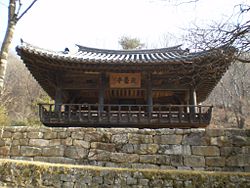Mungyeong
|
Mungyeong 문경시 |
||
|---|---|---|
| Municipal City | ||
| Korean transcription(s) | ||
| • Hangul | ||
| • Hanja | ||
| • Revised Romanization | Mungyeong-si | |
| • McCune-Reischauer | Mun'gyŏng-si | |

The Gyogijeong pavilion at Saejae
|
||
|
||
 Location in South Korea |
||
| Country |
|
|
| Region | Yeongnam | |
| Administrative divisions | 2 eup, 7 myeon, 5 dong | |
| Area | ||
| • Total | 911.73 km2 (352.02 sq mi) | |
| Population (December 31, 2011) | ||
| • Total | 77,304 | |
| • Density | 84.79/km2 (219.6/sq mi) | |
| • Dialect | Gyeongsang | |
Mungyeong (Korean: 문경 Mungyeong (Korean pronunciation: [mun.ɡjʌŋ])) is a city in North Gyeongsang Province, South Korea. The local government, economy, and transportation networks are all centered in Jeomchon, the principal town. Mungyeong has a lengthy history, and is known today for its various historic and scenic tourist attractions. The city's name means roughly "hearing good news."
The city of Mungyeong was created after Jeomchon City and rural Mungyeong County were combined in 1995. It is now an urban-rural complex similar to 53 other small and medium-sized cities with a population under 300,000 people in South Korea.
The Mungyeong area is believed to have been controlled by a mixture of Jinhan and Byeonhan states during the Samhan period in the first centuries of the Common Era. The Jinhan state of Geungi-guk may have been located near Sanyang-myeon. Byeonhan states such as Sabeol-guk and Gosunsi-guk, which probably controlled the Hamchang area of Sangju, may also have extended their control over adjacent areas that are now part of Mungyeong. However, this stage of local history is almost entirely hypothetical, since very little evidence of any kind remains.
At any rate, the rising power of Silla controlled the area by 505. Capitalizing on the territory's strategic potential, Silla set up various mountain fortresses in the area to control movement in and out of western Korea. Control of transit through the area would have gained even greater importance after Silla's 553 seizure of the Han River valley on the western side of the mountains. At this time the low Haneuljae pass near Poam Mountain was probably the favored crossing, in contrast to the higher Mungyeong Saejae pass which came into favor in the Joseon period.
...
Wikipedia

